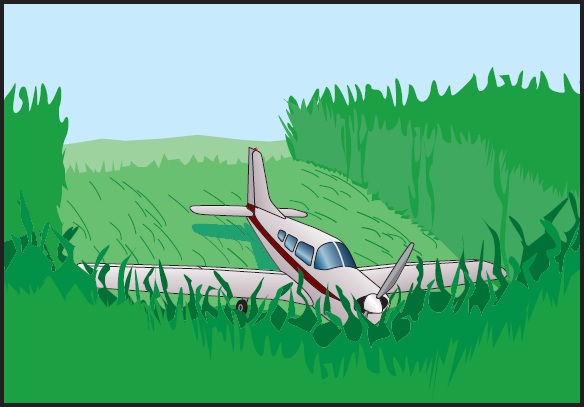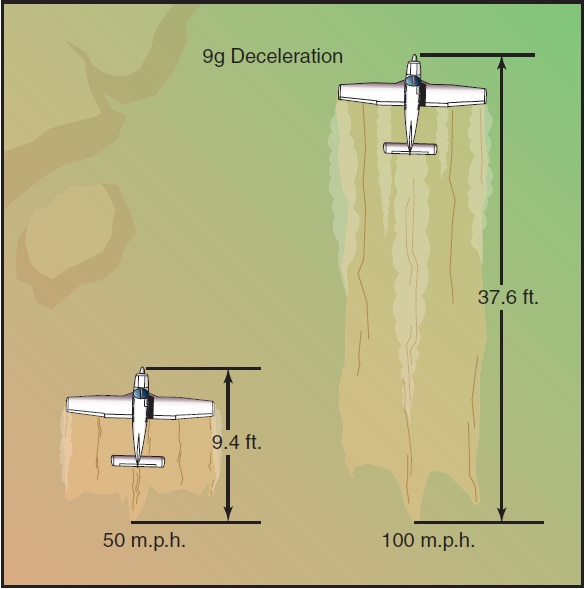
Chapter 16 Emergency Procedures
Table of Contents
Emergency Situations
Emergency Landings
Types of Emergency Landings
Psychological Hazards
Basic Safety Concepts
General
Attitude and Sink Rate Control
Terrain Selection
Airplane Configuration
Approach
Terrain Types
Confined Areas
Trees (Forest)
Water (Ditching) and Snow
Engine Failure After Takeoff (Single-Engine)
Emergency Descents
In-Flight Fire
Engine Fire
Electrical Fires
Cabin Fire
Flight Control Malfunction / Failure
Total Flap Failure
Asymmetric (Split) Flap
Loss of Elevator Control
Landing Gear Malfunction
Systems Malfunctions
Electrical System
Pitot-Static System
Abnormal Engine Instrument Indications
Door Opening In Flight
Inadvertent VFR Flight Into IMC
General
Recognition
Maintaining Airplane Control
Attitude Control
Turns
Climbs
Descents
Combined Maneuvers
Transition to Visual Flight

BASIC SAFETY CONCEPTS
GENERAL
A pilot who is faced with an emergency landing in terrain that makes extensive airplane damage inevitable should keep in mind that the avoidance of crash injuries is largely a matter of: (1) keeping vital structure (cockpit/cabin area) relatively intact by using dispensable structure (such as wings, landing gear, and fuselage bottom) to absorb the violence of the stopping process before it affects the occupants, (2) avoiding forceful bodily contact with interior structure.
The advantage of sacrificing dispensable structure is demonstrated daily on the highways. A head-on car impact against a tree at 20 miles per hour (m.p.h.) is less hazardous for a properly restrained driver than a similar impact against the driver’s door. Accident experience shows that the extent of crushable structure between the occupants and the principal point of impact on the airplane has a direct bearing on the severity of the transmitted crash forces and, therefore, on survivability.
Avoiding forcible contact with interior structure is a matter of seat and body security. Unless the occupant decelerates at the same rate as the surrounding structure, no benefit will be realized from its relative intactness. The occupant will be brought to a stop violently in the form of a secondary collision.
Dispensable airplane structure is not the only available energy absorbing medium in an emergency situation. Vegetation, trees, and even manmade structures may be used for this purpose. Cultivated fields with dense crops, such as mature corn and grain, are almost as effective in bringing an airplane to a stop with repairable damage as an emergency arresting device on a runway. [Figure 16-1] Brush and small trees provide considerable cushioning and braking effect without destroying the airplane. When dealing with natural and manmade obstacles with greater strength than the dispensable airplane structure, the pilot must plan the touchdown in such a manner that only nonessential structure is "used up" in the principal slowing down process.
16-2
Figure 16-1. Using vegetation to absorb energy.
The overall severity of a deceleration process is governed by speed (groundspeed) and stopping distance. The most critical of these is speed; doubling the groundspeed means quadrupling the total destructive energy, and vice versa. Even a small change in groundspeed at touchdown—be it as a result of wind or pilot technique—will affect the outcome of a controlled crash. It is important that the actual touchdown during an emergency landing be made at the lowest possible controllable airspeed, using all available aerodynamic devices.
Most pilots will instinctively—and correctly—look for the largest available flat and open field for an emergency landing. Actually, very little stopping distance is required if the speed can be dissipated uniformly; that is, if the deceleration forces can be spread evenly over the available distance. This concept is designed into the arresting gear of aircraft carriers that provides a nearly constant stopping force from the moment of hookup.
The typical light airplane is designed to provide protection in crash landings that expose the occupants to nine times the acceleration of gravity (9 G) in a forward direction. Assuming a uniform 9 G deceleration, at 50 m.p.h. the required stopping distance is about 9.4 feet. While at 100 m.p.h. the stopping distance is about 37.6 feet—about four times as great. [Figure 16-2] Although these figures are based on an ideal deceleration process, it is interesting to note what can be accomplished in an effectively used short stopping distance. Understanding the need for a firm but uniform deceleration process in very poor terrain enables the pilot to select touchdown conditions that will spread the breakup of dispensable structure over a short distance, thereby reducing the peak deceleration of the cockpit/cabin area.

Figure 16-2. Stopping distance vs. groundspeed.
PED Publication